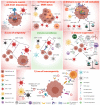Mechanisms of Immune Escape and Resistance to Checkpoint Inhibitor Therapies in Mismatch Repair Deficient Metastatic Colorectal Cancers
- PMID: 34072037
- PMCID: PMC8199207
- DOI: 10.3390/cancers13112638
Mechanisms of Immune Escape and Resistance to Checkpoint Inhibitor Therapies in Mismatch Repair Deficient Metastatic Colorectal Cancers
Abstract
Immune checkpoint inhibitors (CPIs) represent an effective therapeutic strategy for several different types of solid tumors and are remarkably effective in mismatch repair deficient (MMRd) tumors, including colorectal cancer (CRC). The prevalent view is that the elevated and dynamic neoantigen burden associated with the mutator phenotype of MMRd fosters enhanced immune surveillance of these cancers. In addition, recent findings suggest that MMRd tumors have increased cytosolic DNA, which triggers the cGAS STING pathway, leading to interferon-mediated immune response. Unfortunately, approximately 30% of MMRd CRC exhibit primary resistance to CPIs, while a substantial fraction of tumors acquires resistance after an initial benefit. Profiling of clinical samples and preclinical studies suggests that alterations in the Wnt and the JAK-STAT signaling pathways are associated with refractoriness to CPIs. Intriguingly, mutations in the antigen presentation machinery, such as loss of MHC or Beta-2 microglobulin (B2M), are implicated in initial immune evasion but do not impair response to CPIs. In this review, we outline how understanding the mechanistic basis of immune evasion and CPI resistance in MMRd CRC provides the rationale for innovative strategies to increase the subset of patients benefiting from CPIs.
Keywords: MSI; colorectal cancer; immune checkpoint inhibitors; immune escape; immune evasion; immune surveillance; microsatellite instability; mismatch repair deficiency.
Conflict of interest statement
A.B. and G.G. are cofounders and shareholders of NeoPhore limited. A.B. is a member of the NeoPhore scientific advisory board. A.S.-B. is an advisory board member for Amgen, Bayer, Sanofi, Servier, and MSD. S.S. is an advisory board member for Amgen, Bayer, BMS, CheckmAb, Clovis, Daiichi-Sankyo, Merck, Roche-Genentech, and Seattle Genetics.
Figures


Similar articles
-
Immune escape and resistance to immunotherapy in mismatch repair deficient tumors.Front Immunol. 2023 Jul 10;14:1210164. doi: 10.3389/fimmu.2023.1210164. eCollection 2023. Front Immunol. 2023. PMID: 37492581 Free PMC article. Review.
-
Genetic and pharmacological modulation of DNA mismatch repair heterogeneous tumors promotes immune surveillance.Cancer Cell. 2023 Jan 9;41(1):196-209.e5. doi: 10.1016/j.ccell.2022.12.003. Epub 2022 Dec 29. Cancer Cell. 2023. PMID: 36584674 Free PMC article.
-
CD4 T Cell-Dependent Rejection of Beta-2 Microglobulin Null Mismatch Repair-Deficient Tumors.Cancer Discov. 2021 Jul;11(7):1844-1859. doi: 10.1158/2159-8290.CD-20-0987. Epub 2021 Mar 2. Cancer Discov. 2021. PMID: 33653693
-
Hypermutated tumours in the era of immunotherapy: The paradigm of personalised medicine.Eur J Cancer. 2017 Oct;84:290-303. doi: 10.1016/j.ejca.2017.07.026. Epub 2017 Aug 29. Eur J Cancer. 2017. PMID: 28846956 Review.
-
Results and challenges of immune checkpoint inhibitors in colorectal cancer.Expert Opin Biol Ther. 2018 May;18(5):561-573. doi: 10.1080/14712598.2018.1445222. Epub 2018 Feb 28. Expert Opin Biol Ther. 2018. PMID: 29471676 Review.
Cited by
-
Predictive biomarkers of colon cancer immunotherapy: Present and future.Front Immunol. 2022 Nov 22;13:1032314. doi: 10.3389/fimmu.2022.1032314. eCollection 2022. Front Immunol. 2022. PMID: 36483562 Free PMC article. Review.
-
Combined signature of G protein-coupled receptors and tumor microenvironment provides a prognostic and therapeutic biomarker for skin cutaneous melanoma.J Cancer Res Clin Oncol. 2023 Dec;149(20):18135-18160. doi: 10.1007/s00432-023-05486-4. Epub 2023 Nov 25. J Cancer Res Clin Oncol. 2023. PMID: 38006451 Free PMC article.
-
Prognostic and tumor immunity implication of inflammatory bowel disease-associated genes in colorectal cancer.Eur J Med Res. 2022 Jun 13;27(1):91. doi: 10.1186/s40001-022-00720-0. Eur J Med Res. 2022. PMID: 35698180 Free PMC article.
-
Cellular and Molecular Mechanisms of the Tumor Stroma in Colorectal Cancer: Insights into Disease Progression and Therapeutic Targets.Biomedicines. 2023 Aug 23;11(9):2361. doi: 10.3390/biomedicines11092361. Biomedicines. 2023. PMID: 37760801 Free PMC article. Review.
-
Resistance to systemic immune checkpoint inhibition in the peritoneal niche.J Immunother Cancer. 2022 Jun;10(6):e004749. doi: 10.1136/jitc-2022-004749. J Immunother Cancer. 2022. PMID: 35728873 Free PMC article.
References
-
- Planchard D., Popat S., Kerr K., Novello S., Smit E.F., Faivre-Finn C., Mok T.S., Reck M., Van Schil P.E., Hellmann M.D., et al. Metastatic non-small cell lung cancer: ESMO Clinical Practice Guidelines for diagnosis, treatment and follow-up. Ann. Oncol. 2018;29:iv192–iv237. doi: 10.1093/annonc/mdy275. - DOI - PubMed
-
- Baas P., Scherpereel A., Nowak A.K., Fujimoto N., Peters S., Tsao A.S., Mansfield A.S., Popat S., Jahan T., Antonia S., et al. First-line nivolumab plus ipilimumab in unresectable malignant pleural mesothelioma (CheckMate 743): A multicentre, randomised, open-label, phase 3 trial. Lancet. 2021;397:375–386. doi: 10.1016/S0140-6736(20)32714-8. - DOI - PubMed

